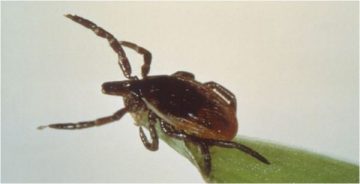Photo: Anna Perez
by Pam Dillon
It’s official. Ottawa is a risk area for Lyme disease. Last year, over 20 per cent of ticks tested by Ottawa Public Health were Lyme disease carriers. What’s more, since 2010 the number of Lyme disease cases has shot up from seven to 75 in 2016.
The risk is real. And ticks? They’re not just in the back woods. They’re in suburbia too.
In early April, when there was still snow on the ground, I noticed an annoying itch behind my ear. Out came a mirror, the ear was pulled back, and there it was: a tick.
In February, my dog tested positive for Lyme disease and last summer, on a hot July day as I was rushing out to a meeting, I glanced down to see a tick attached to my wrist. It looked like a miniature version of one of those flattened witches you see at Halloween.
Panicking, I yanked it out, put it in a closed glass container, cleaned my arm and left.
When I got home, the tick was gone. Presumably loose in my house. How’s that for horror?
In the Ottawa region and beyond, ticks are a fact of life. Whether you’re a camper, hiker, cottager, nature buff or the parent of children who (hopefully) play outside, it’s best to take action to protect your family from Lyme disease.
Here are the facts, courtesy of Ottawa Public Health (OPH) and its web page:
Most people are infected with Lyme disease through the bite of tiny tick called a nymph. Nymphs are about the size of a poppy seed. They are difficult to see, and they feed during the spring and summer months. Adult ticks are larger and more likely to be removed before they transmit the Lyme disease bacteria. Adult blacklegged ticks are most active during spring, late summer and fall.
Avoid Contact
Follow these steps to minimize exposure to ticks:
Apply a Health Canada approved mosquito repellent containing DEET or icaridin to exposed skin and clothing.
Wear long pants, a long sleeved shirt, shoes and socks to cover your skin.
Tuck your pants into socks.
Wear light coloured clothing to spot ticks more easily.
Try to stay on trails when in the woods or walking in long grass.
After an outing, do a full-body tick check on yourself, your children and your pets. Check your toes, knees, groin, armpits and scalp carefully.
Reduce the Numbers
There are ways to make your outdoor living space less tick friendly.
Keep the grass cut.
Remove brush and fallen leaves from your property, especially if trees or tall grass border it.
Clean around bird feeders to keep away small critters, such as mice and voles, that carry ticks.
Discourage deer from visiting, since ticks feed on them too.
Keeping your woodpile neat, off the ground and away from your house.
Talk to your vet about options to protect your pet from ticks.
Deal with the Bite
If a tick has bitten you, the sooner it is removed the less likely it is to spread Lyme disease.
To remove it, grasp its head as close to the skin as possible and pull slowly until it is out and away from your skin. Do not twist or rotate as you pull.
See your doctor so he or she can decide if you need antibiotics.
Source: http://ottawa.ca/en/residents/public-health/disease-and-medical-conditions#lyme-disease







